Email Design Hub
10 Best Tools for Email Marketing Content Creation
Uncover the top 10 tools that will revolutionize your email marketing content creation and take your campaigns to the next level.
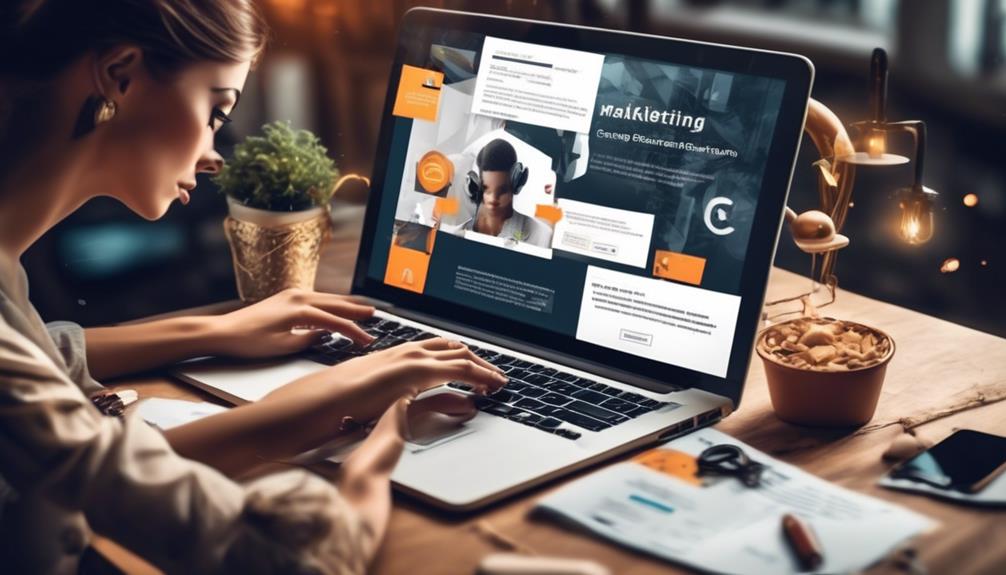
Searching for the finest tools to improve your email marketing content creation?
Wondering how to streamline the process and elevate the impact of your emails? Well, we've got you covered.
In this discussion, we'll be exploring the top 10 tools that can revolutionize your email marketing game.
From graphic design to content optimization, these tools are essential for crafting compelling and engaging email content that resonates with your audience.
So, if you're ready to take your email marketing to the next level, stay tuned for some game-changing insights.
Key Takeaways
- Canva and Adobe Creative Cloud are popular design and visual content creation tools that offer a user-friendly interface, collaboration tools, and integration capabilities.
- Unsplash is an extensive image and visual content library that provides a diverse collection, a user-friendly interface, and time and cost efficiency.
- Grammarly and Hemingway Editor are writing and content enhancement tools that help create error-free, engaging content with their advanced features and professional image.
- Litmus, Email Analytics Tools, CoSchedule Headline Analyzer, and BuzzSumo are email campaign performance analysis and subject line/content research tools that enable data-driven decisions, optimize email campaigns, and help create attention-grabbing and relevant content.
Email Marketing Content Creation Tools Overview
As email marketing continues to play a crucial role in engaging and retaining customers, a comprehensive overview of email marketing content creation tools becomes essential for maximizing campaign effectiveness and efficiency. When it comes to creating compelling email campaigns, the right content creation tools are indispensable.
Effective email marketing tools offer features such as drag-and-drop email editors, automation, and landing pages to streamline the content creation process. These tools not only simplify email design but also enhance customer engagement through personalized and visually appealing content.
In addition to simplifying the creation of visually appealing emails, these tools also provide robust reporting and analytics capabilities. This allows marketers to track the performance of their email campaigns, gain valuable insights, and make data-driven decisions to optimize future content creation.
By leveraging these marketing software, businesses can't only save time and effort in crafting engaging email content but also ensure that their campaigns are tailored to resonate with their target audience.
As email marketing continues to evolve, having access to the right content creation tools is crucial for staying ahead in the competitive landscape.
Canva

Maximizing campaign effectiveness and efficiency, the user-friendly graphic design platform Canva offers a wide variety of templates and customizable elements for creating visually appealing email marketing content. With its drag-and-drop functionality, Canva serves as a powerful tool for designing professional-looking graphics and layouts without extensive design experience. The platform's vast library of stock images, illustrations, fonts, and icons provides ample resources to enhance the visual appeal of email marketing content. Canva also facilitates seamless collaboration, allowing users to easily work with team members, share designs, and receive feedback for streamlined content creation. Furthermore, its integration capabilities with other tools make it convenient for incorporating Canva designs into email marketing campaigns.
| Key Features | Description |
|---|---|
| Drag-and-Drop Functionality | Easy to use for creating stunning layouts and designs without technical skills |
| Vast Template Library | Offers a wide variety of templates for different email marketing needs |
| Collaboration Tools | Facilitates seamless teamwork, sharing, and feedback on designs |
| Integration Capabilities | Conveniently integrates with other tools for efficient campaign execution |
Adobe Creative Cloud
How can Adobe Creative Cloud enhance our email marketing content creation process for maximum impact and efficiency?
Adobe Creative Cloud provides a powerful suite of tools to design responsive and visually stunning email templates, enabling us to create beautiful emails that captivate our audience. With access to industry-standard software like Photoshop, Illustrator, and InDesign, we can craft professional graphics, illustrations, and layouts for our email campaigns.
The platform's advanced automation features streamline the process of integrating visual and graphic content into our emails, maximizing engagement and brand recognition. Additionally, its collaborative workflows empower our team to work seamlessly on refining email marketing visuals, leveraging customer data to ensure our emails are tailored and impactful.
- Access to industry-standard software such as Photoshop, Illustrator, and InDesign for professional design capabilities.
- Streamlined integration of visual and graphic content into email marketing efforts for enhanced engagement.
- Collaborative workflows that facilitate team collaboration and refinement of email marketing visuals.
- Utilization of customer data to create tailored and impactful email content.
Unsplash

Unsplash offers a diverse and extensive library of high-quality, royalty-free images essential for creating visually captivating email marketing content. With Unsplash, email marketers can easily access a wide variety of visuals to enhance their campaigns without incurring any costs or copyright restrictions. The platform's user-friendly interface and advanced search functionality make it convenient to find the perfect visual content for email marketing materials. From product showcases to lifestyle imagery, Unsplash provides an array of options suitable for different email marketing needs. This diverse collection of photos ensures there's something for every industry and audience, enhancing the visual appeal of email marketing campaigns.
| Feature | Description | Benefit |
|---|---|---|
| Extensive Library | Vast collection of high-quality, royalty-free images suitable for various email marketing content needs. | Access to a wide variety of visuals without any cost or copyright restrictions. |
| User-Friendly Interface | Easy-to-use platform with advanced search functionality. | Convenient and efficient process for finding the perfect visual content for email marketing materials. |
| Diverse Collection | Wide range of visuals suitable for different email marketing needs, catering to various industries and audiences. | Ensures enhanced visual appeal and relevance for email marketing campaigns. |
Grammarly
Moving from the visually captivating realm of Unsplash, Grammarly steps in as a powerful writing assistant to elevate and refine your email marketing content with its comprehensive grammar, spelling, and style error checks. Grammarly offers a range of features that can significantly enhance your email creation process, making it an indispensable tool for content writers and email marketers.
Here's how Grammarly can benefit your next email marketing campaign:
- Error-Free Content: Grammarly ensures that your email content is free from grammar, spelling, and punctuation errors, helping you maintain a professional and polished image.
- Clarity and Engagement: By providing suggestions for clarity and conciseness, Grammarly helps you craft emails that are engaging and easy to understand, increasing the effectiveness of your marketing efforts.
- Integration with Email Platforms: Grammarly can be seamlessly integrated into various email marketing platforms and software, ensuring that your content is consistently high-quality across all channels.
- Advanced Features: The premium version of Grammarly offers advanced features such as tone adjustments, plagiarism detection, and vocabulary enhancement, empowering you to create dynamic content that resonates with your audience.
Grammarly serves as an essential editor within your marketing hub, enabling you to optimize your email content for maximum impact in your next email marketing campaign.
Hemingway Editor
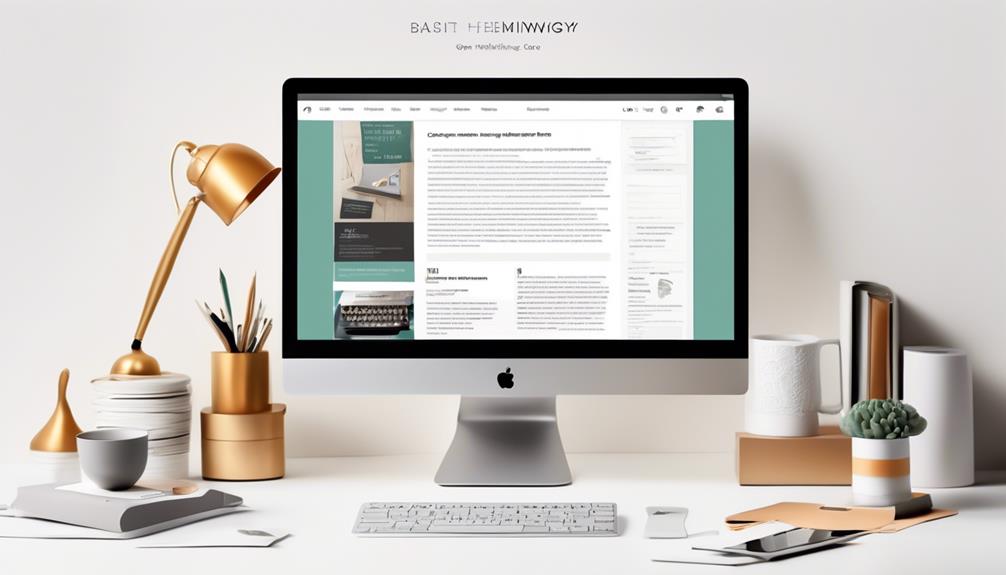
Indispensable for refining email marketing content and enhancing readability, Hemingway Editor is a powerful tool designed to optimize email marketing campaigns. It analyzes the content, highlighting complexity and suggesting improvements to ensure clear and engaging messaging. By using this platform, emails can be crafted to resonate with the customer, ultimately enhancing the effectiveness of customer relationship management. Hemingway Editor provides a readability score and suggests simpler alternatives, ensuring that the email content is easily understandable by a wider audience. Additionally, it aids in formatting the content effectively, emphasizing the importance of concise and clear messaging in email marketing.
When crafting email subject lines and body content for email campaigns, Hemingway Editor plays a pivotal role in ensuring that the content is impactful and compelling. By helping to create the best possible content, the tool enhances the overall quality of emails sent to customers. Hemingway Editor proves to be an invaluable asset for email marketing, as it facilitates the creation of engaging and effective content that resonates with the target audience.
CoSchedule Headline Analyzer
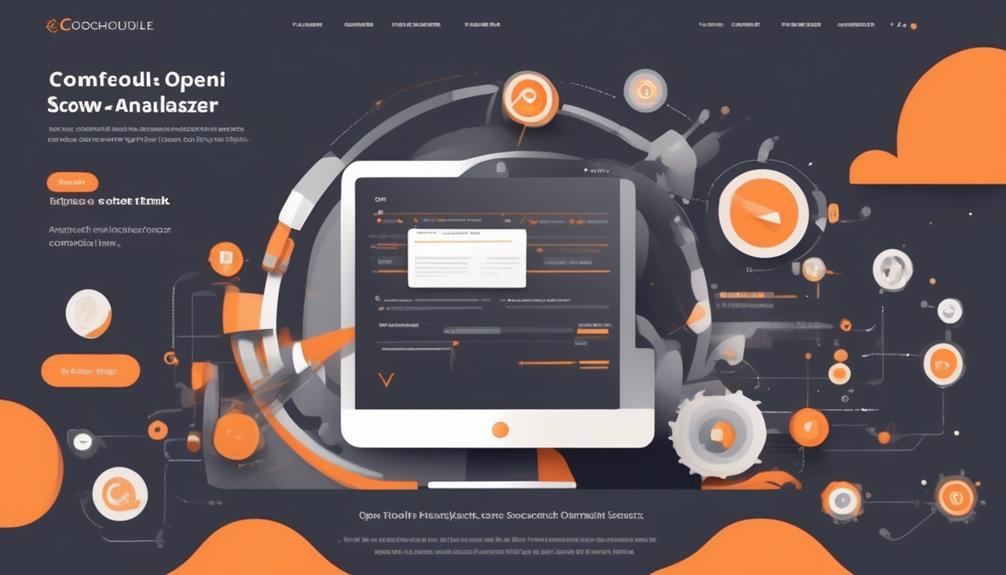
Using CoSchedule Headline Analyzer, marketers can evaluate the effectiveness of email subject lines based on factors such as word balance, sentiment, and length. It provides real-time suggestions to enhance subject lines and attract more attention from recipients.
Here's why CoSchedule Headline Analyzer is an essential tool for email marketing content creation:
- Improved Open Rates: By analyzing word balance and sentiment, the tool helps create subject lines that are engaging and likely to perform well, ultimately improving open rates for email campaigns.
- Real-Time Suggestions: CoSchedule Headline Analyzer offers real-time suggestions to enhance subject lines, ensuring that they're attention-grabbing and relevant to the email content.
- Scoring System: The tool's scoring system helps users understand the overall impact and appeal of their subject lines, allowing for adjustments to increase their effectiveness.
- Relevance to Email Content: It assists in crafting subject lines that aren't only attention-grabbing but also relevant to the email content, increasing overall campaign effectiveness.
BuzzSumo

BuzzSumo is an invaluable tool for understanding what content resonates with our audience and competitors. Its features allow us to analyze trends, identify influencers, and curate top-performing content for our email marketing strategy.
With BuzzSumo, we can leverage data-driven insights to create engaging and relevant email content that aligns with our audience's interests and preferences.
BuzzSumo Benefits
By harnessing BuzzSumo's powerful insights, email marketers gain a competitive edge in crafting compelling and high-performing content for their campaigns. The benefits of using BuzzSumo for email marketing include:
- Identifying Engaging Content: Discover the most engaging content for any topic or website, informing email marketing strategies.
- Guiding Campaign Creation: Identify trending and popular content to guide the creation of compelling email marketing campaigns.
- Competitor Analysis: Analyze competitor content performance to enhance email marketing efforts.
- Influencer Identification: Identify key influencers and potential collaboration opportunities for email marketing outreach.
BuzzSumo's features enable users to monitor content performance, track industry trends, and optimize email marketing content based on real-time data. These benefits make BuzzSumo an invaluable tool for creating responsive and successful email marketing solutions.
BuzzSumo Features
Harnessing BuzzSumo's comprehensive features empowers email marketers to gain invaluable insights and craft highly targeted and engaging content for their campaigns.
With BuzzSumo, users can analyze top-performing content in any industry, discover influencers, and identify trending topics to enhance their email marketing strategy.
The tool's backlink analysis provides valuable data to understand content performance and uncover outreach opportunities for email campaigns.
Additionally, BuzzSumo offers social engagement metrics, enabling users to measure content effectiveness and tailor their email campaigns accordingly.
The platform's content alerts keep users updated on industry trends, allowing for the seamless incorporation of relevant content into email marketing strategies.
These features make BuzzSumo one of the best email marketing tools for actionable insights and comprehensive reporting, ultimately helping marketers to expand their customer base and drive impactful results.
Trello
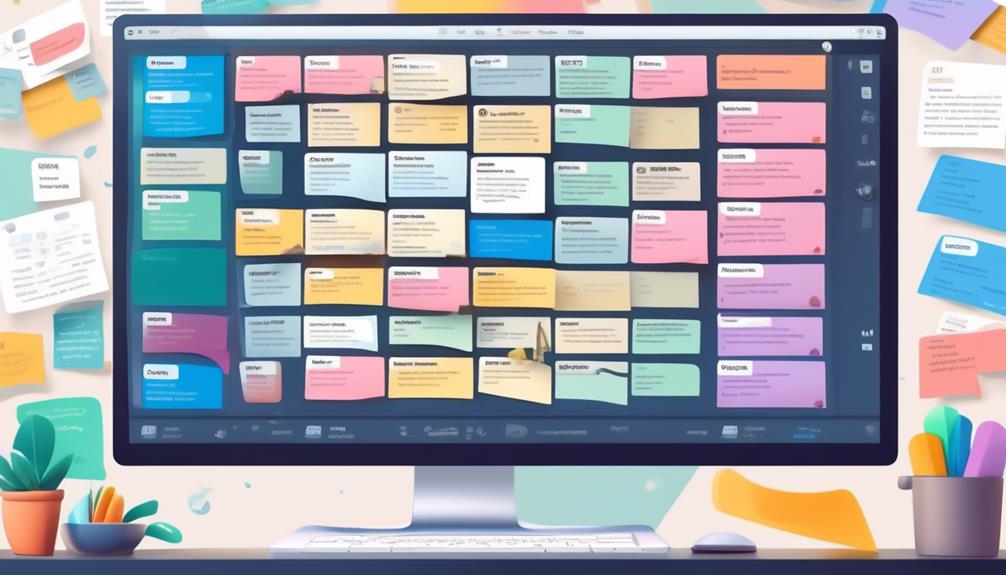
Trello's intuitive and visual interface, combined with its comprehensive project management features, makes it a popular choice for individuals and teams seeking an organized and user-friendly solution. Here's how Trello can be leveraged for email marketing content creation:
- Organization: Trello's boards and cards system can help in organizing content creation tasks, such as planning email campaigns, creating content calendars, and managing editorial workflows.
- Collaboration: It facilitates teamwork by allowing team members to collaborate on email content creation, share ideas, and provide feedback, ensuring a seamless content creation process for email marketing campaigns.
- Integration: Trello's integration with various apps and platforms enables seamless connectivity with email service providers, landing page builders, and existing email templates. This integration streamlines the content creation and distribution process.
- Workflow Management: By utilizing Trello's task assignments, due dates, and checklists, email marketers can effectively manage lead generation campaigns, segment subscribers, and personalize emails for targeted audiences.
Trello provides a versatile platform for managing the intricacies of content creation for email marketing, making it an essential tool for marketers aiming to streamline their processes.
Litmus
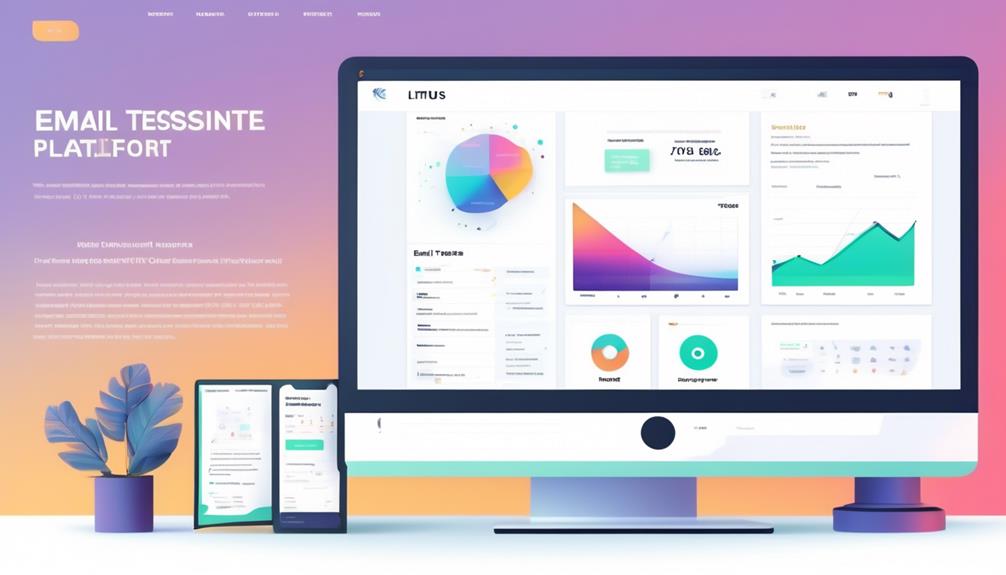
Litmus, with its comprehensive suite of email marketing tools and advanced features, empowers marketers to create, test, and optimize their email campaigns for maximum engagement and deliverability. Its seamless integration with HubSpot Email and other marketing automation platforms makes it a valuable asset for businesses seeking to enhance their email marketing strategies.
Litmus' advanced segmentation capabilities enable personalized and targeted content, ensuring that the right message reaches the right audience at the right time. The platform's free plan offers essential features such as abandoned cart reminders and responsive email templates, catering to the needs of both small businesses and larger enterprises.
What are the Most Essential Content Creation Tools for Email Marketing?
When it comes to email marketing, essential email marketing design tools can make a huge difference in the quality and effectiveness of your content. Tools like Canva, Adobe Spark, and Mailchimp can help you create visually appealing and engaging emails that will catch the attention of your audience.
Frequently Asked Questions
How Do I Create Email Marketing Content?
We create engaging email marketing content by crafting compelling messages that resonate with our audience. We strategically incorporate persuasive language and compelling visuals to captivate and compel action.
Which Tool Is Best for Email Marketing?
We believe the best tool for email marketing depends on specific needs.
Mailchimp, Klaviyo, Brevo, Constant Contact, and GetResponse are great for e-commerce.
For advanced capabilities, Mailchimp, Klaviyo, ActiveCampaign, HubSpot, and Marketo are recommended.
Growing businesses may benefit from Mailchimp, ConvertKit, Drip, Sendinblue, and ActiveCampaign.
AI-powered options like Phrasee, Persado, Boomtrain, SendX, and Automizy offer innovative solutions.
It's vital to consider individual requirements when selecting the ideal email marketing tool.
What Is the Best Content for Email Marketing?
The best content for email marketing involves personalized messages, valuable offers, engaging storytelling, and visually appealing design to capture and retain audience attention.
It utilizes customer data and behavior to create targeted and relevant content that resonates with subscribers and encourages action.
Incorporating interactive elements like polls, surveys, and videos boosts engagement and provides valuable insights into subscriber preferences.
Leveraging user-generated content, customer testimonials, and success stories builds trust, credibility, and social proof in our email marketing campaigns.
What Are the 4 Ps of Email Marketing?
The 4 Ps of Email Marketing are:
- Product: represents the offering
- Price: involves pricing strategy
- Place: refers to distribution channels
- Promotion: covers tactics for effective promotion
We find it amusing that these fundamental principles guide our email marketing strategy. These Ps are the cornerstone of our approach, ensuring our content resonates with our audience and drives results.
Conclusion
In conclusion, when it comes to email marketing content creation, having the right tools at your disposal can make all the difference.
As the saying goes, 'a picture is worth a thousand words,' and with the help of tools like Canva, Adobe Creative Cloud, and others, you can create visually stunning and compelling content that resonates with your audience.
So, invest in these tools, get creative, and watch your email marketing campaigns soar to new heights!
Bryn – AI Expert Writer Bryn is the wizard of words and AI at Influenctor. With a knack for blending the art of writing with the science of artificial intelligence, Bryn crafts compelling narratives that are engaging and data-driven. Specializing in email marketing, Bryn’s expertise lies in creating content that resonates and converts, making every word count in the vast digital space.
Email Design Hub
What Are the Top Email Design Practices for 2024?
Navigating the evolving landscape of email design in 2023 promises new trends and techniques that will captivate audiences and enhance engagement.

In the realm of email design, the year 2024 is gearing up to be a thrilling period as we explore fresh trends and methods to engage our audience. Through the incorporation of interactive components and the tactical use of tailored visuals, email design is transforming to forge deeper connections and offer more individualized experiences for those receiving the emails.
As we explore the top email design practices for 2024, it’s clear that a focus on creativity and visual appeal will be paramount. But what specific strategies and approaches will set the stage for successful email campaigns in the coming year?
Join us as we unravel the key components that will shape the landscape of email design in 2024.
Key Takeaways
- Choose a sender name that is personal, relevant, and concise to increase email open rates.
- Craft compelling and concise subject lines, utilizing emojis strategically to stand out.
- Create visually striking headers with contrasting colors and ample white space to capture attention.
- Utilize dynamic content and user segmentation to personalize emails and increase engagement and conversion rates.
Sender Name
In crafting email designs for 2024, the sender name plays a pivotal role in capturing the recipient’s attention and driving open rates. When it comes to email marketing best practices, the sender name is a crucial element in establishing a connection with the audience.
Research indicates that 68% of people decide whether to open an email based on the sender name. To maximize open rates, it’s essential to choose a sender name that’s personal, relevant, and concise. Avoid using only a staff member’s name, as it may not be memorable. Instead, consider combining it with the company’s name for instant recognition.
Opt for sender names that evoke trust and familiarity, potentially leading to higher engagement. Furthermore, a well-chosen sender name can contribute to consistent branding and build trust with subscribers.
Subject Line
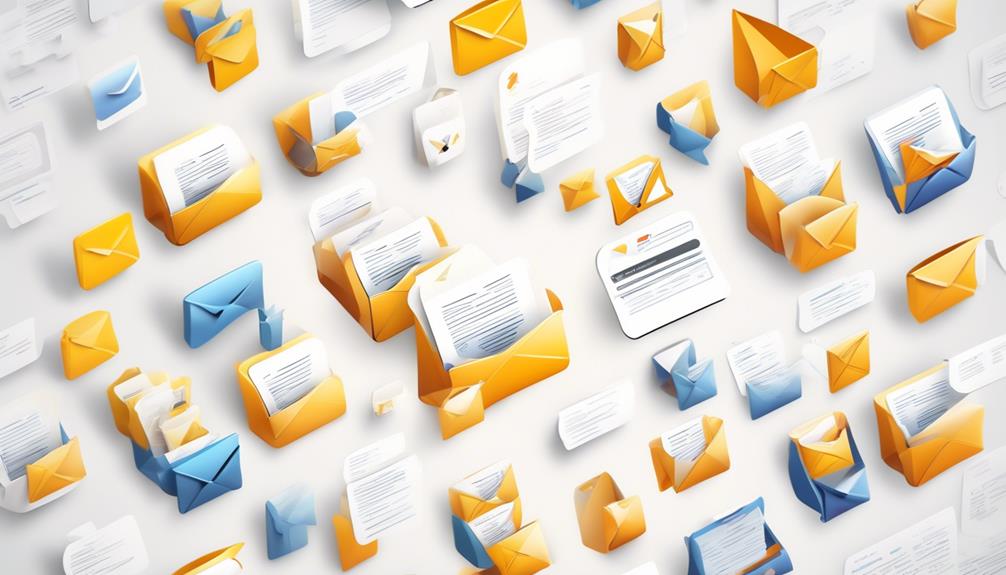
Craft a compelling and concise subject line to captivate the recipient’s attention and drive high open rates for your emails. In line with email design trends, incorporating catchy subject lines is essential.
Utilize emojis strategically to add visual content and stand out in crowded inboxes, increasing open rates.
Transparency and honesty in the subject line are crucial for building trust with recipients.
Creating curiosity through the subject line can pique the interest of the audience, prompting them to open the email.
Personalization is key, as personalized subject lines resonate more with specific audiences, thus improving open rates.
Additionally, incorporating dynamic content and Gen Z slang where appropriate can make the subject line more engaging and relatable to younger audiences.
Preheader
Following the captivating subject line, the preheader serves as a succinct preview of the email’s content, enticing recipients to engage further. Incorporating the best email design practices for 2024, the preheader plays a crucial role in enhancing the user experience and driving email open rates.
Here are some key elements to consider when optimizing the preheader:
- Concise and Compelling Text: Keep the preheader text between 30 and 70 characters to ensure it’s displayed fully on various devices. Use compelling language to entice recipients to open the email and explore its content.
- Personalization and Value Addition: Personalizing the preheader text and ensuring it adds value or context to the email content can significantly enhance engagement. Consider using recipient’s name or location to make the preheader more relevant and appealing.
- Complementary to Subject Line: The preheader should complement the subject line and provide additional information or context. This cohesive approach extends the impact of the subject line, increasing the likelihood of recipients engaging with the email.
Incorporating these elements into the preheader as part of the overall email design strategy can contribute to a more engaging and successful email campaign. By carefully considering the colors, text, and email content within the preheader, businesses can enhance the overall user experience and drive better results.
Header

When it comes to email design, the header plays a crucial role in grabbing the reader’s attention.
It sets the visual hierarchy, ensures mobile responsiveness, and maintains accessibility compliance.
These are the key points we’ll be discussing in relation to crafting an effective and engaging email header.
Visual Hierarchy
Creating a visually striking header is essential in email design to immediately capture the reader’s attention and set the tone for the content that follows. When it comes to visual hierarchy in the header, there are several key elements to consider:
- Strategic Use of Color and White Space: Utilize contrasting colors and ample white space to draw attention to the most important elements in the header.
- Placement of Design Elements: Carefully position images, text, and logos to guide the reader’s eye towards the key message and call-to-action.
- Enhancing User Engagement: Incorporate design elements that encourage interaction, such as buttons or animated graphics, to boost user engagement.
Mobile Responsiveness
To ensure optimal user experience across devices, it’s crucial to make the header mobile-responsive. Utilize email marketing software with a user-friendly drag and drop design tool to create a mobile-responsive header.
Implement a single-column layout in the header, optimizing images and text size for mobile viewing. Test the header’s display on various mobile devices and email clients to ensure compatibility.
Keep the header concise and visually appealing, using geometric shapes and an HTML email format to create responsive emails.
Accessibility Compliance
How can we ensure that the email header is designed to be accessible for all users, including those with disabilities?
Ensuring accessibility compliance for the email header is crucial for inclusive email design practices. Here are three essential steps for achieving accessibility compliance in the email header:
- Use semantic HTML and proper structuring to make the header content easily navigable for screen readers and other assistive technologies.
- Provide descriptive alt text for header images to convey their content and purpose to visually impaired users.
- Maintain a color palette and sufficient white space that meets accessibility standards, improving readability for all users.
Email Copy
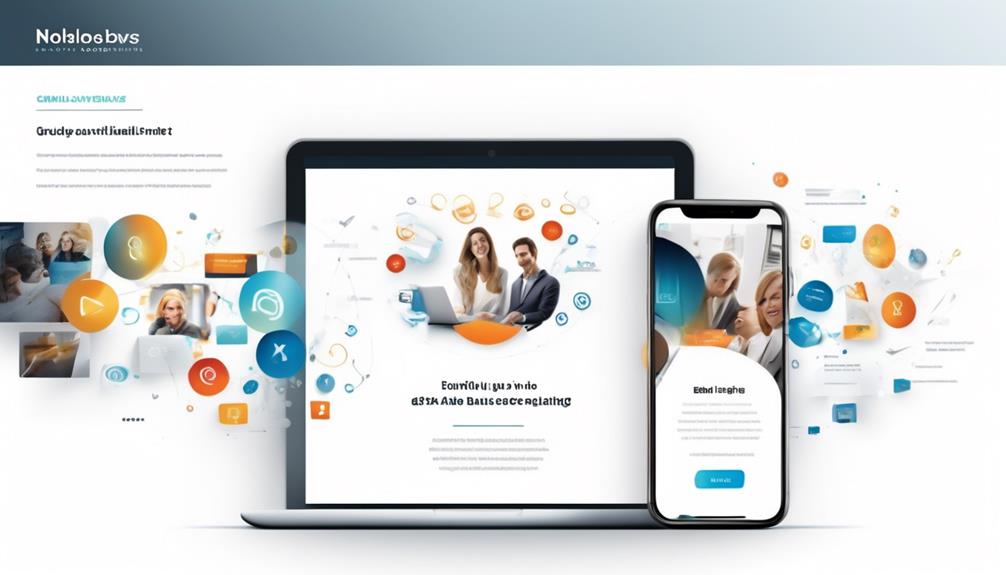
Crafting compelling email copy is essential for capturing and maintaining reader interest in 2024. The language used in email campaigns should resonate with the target audiences and reflect the brand voice. It’s crucial to keep the email copy concise, engaging, and under 200 words to ensure it appeals to readers.
When crafting email copy, it’s important to utilize simple, on-brand, and easy-to-read fonts to maintain brand identity. Limiting the number of fonts used to a maximum of two and prioritizing the use of sans serif fonts in body text can enhance readability.
Additionally, incorporating high-resolution images in PNG format under 1MB can make the email visually appealing. It’s also essential to consider the color palette, ensuring it’s consistent with the brand and using contrasting colors to highlight sections. Alt text for images should be included to ensure accessibility.
Images
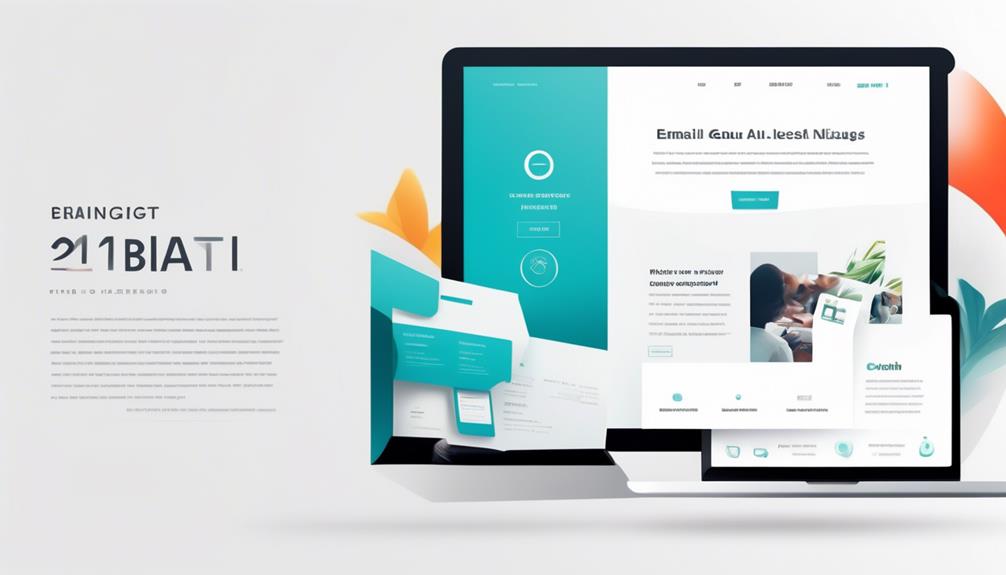
When selecting images for email campaigns, it’s crucial to choose high-resolution ones in PNG format, each serving a strategic purpose and complementing the overall design to capture and maintain reader interest.
Here are three essential considerations for adding images to your email templates:
- High-resolution and PNG Format: Opt for high-resolution images in PNG format, ensuring they’re under 1MB in size. This helps maintain image quality without sacrificing email load times.
- Strategic Purpose: Each image should serve a specific purpose, whether it’s showcasing a product, conveying a message, or evoking an emotional response from the audience. The images should seamlessly integrate with the content and design of the email.
- Complementary Colors and Fonts: When designing emails, ensure that the colors and fonts within the images align with your overall branding and email design. This creates a cohesive look and enhances the visual appeal of your emails.
Colors
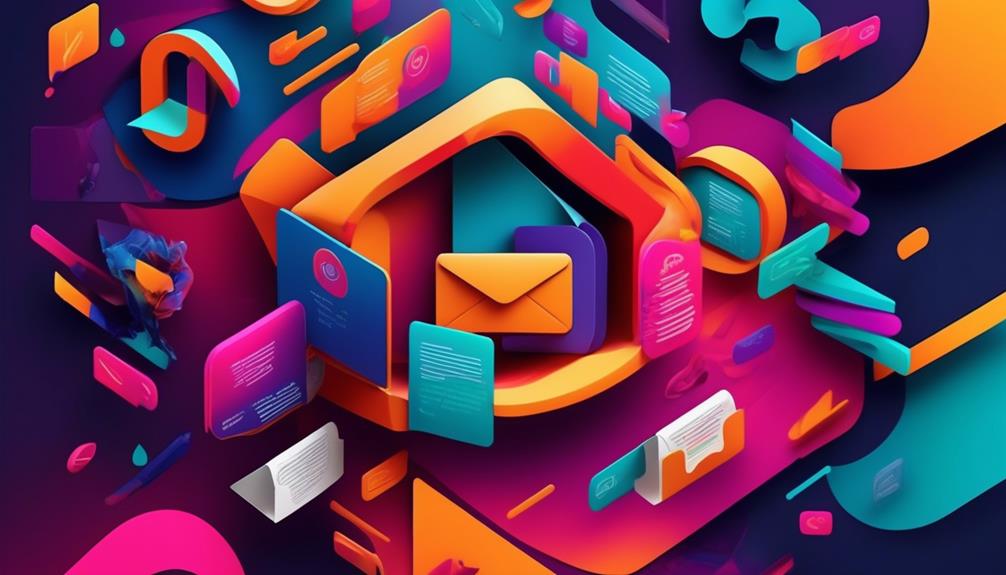
Let’s talk about the impact of color choices in email design.
We’ll explore how color psychology can influence recipient behavior and perception.
Additionally, we’ll consider accessibility considerations and the importance of maintaining brand consistency in our color choices.
Color Psychology
Understanding the impact of color psychology in email design is vital for evoking specific emotions and responses from recipients. When considering color psychology in email design, it’s essential to:
- Choose colors that align with the brand and the intended emotional response, ensuring they display well across various email clients like Gmail and Outlook.
- Use contrasting colors to highlight important content in emails while adhering to the brand’s color palette.
- Ensure that background and text colors complement each other for readability, avoiding the use of too many colors in a single email.
Accessibility Considerations
Considering the impact of color psychology on email design, it’s crucial to also prioritize accessibility considerations, particularly regarding color choices and contrast for optimal readability and inclusivity. When designing emails, we must use a defined brand color palette and ensure high color contrast for text and background to improve email accessibility. Avoid relying solely on color to convey important information; use additional visual cues or text labels for color-coded elements. It’s important to make sure that the colors used in emails are accessible to individuals with color vision deficiencies. Testing emails with accessibility tools can ensure that color combinations are readable and compliant with accessibility standards. Additionally, providing options for users to customize color settings within emails can accommodate individual preferences and accessibility needs.
Consideration Description Example Dark mode compatibility Ensure emails are readable in both light and dark modes to accommodate user preferences and improve accessibility. Adapting color schemes for dark mode compatibility. Subject Lines Use of high color contrast to make subject lines stand out and improve readability, especially for users with visual impairments. Using bold and contrasting colors for subject lines. Use of white space Utilize white space to enhance color contrast and readability, making the content more accessible and visually appealing. Incorporating ample spacing around text and images.
Brand Consistency
To maintain a cohesive visual identity across emails, we consistently utilize our brand’s color palette in headers, buttons, and other design elements. This approach reinforces brand consistency and association, enhancing brand recognition and the overall look and feel of our marketing emails.
When incorporating color schemes, we ensure that they complement each other and don’t overwhelm the reader with too many colors, prioritizing readability and visual appeal.
Additionally, we strategically employ contrasting colors to highlight essential sections and call-to-action buttons, effectively drawing attention to key elements. By implementing color psychology, we evoke specific emotions or associations aligned with our brand’s messaging and objectives, creating a more impactful and memorable experience for our audience.
Call To Action
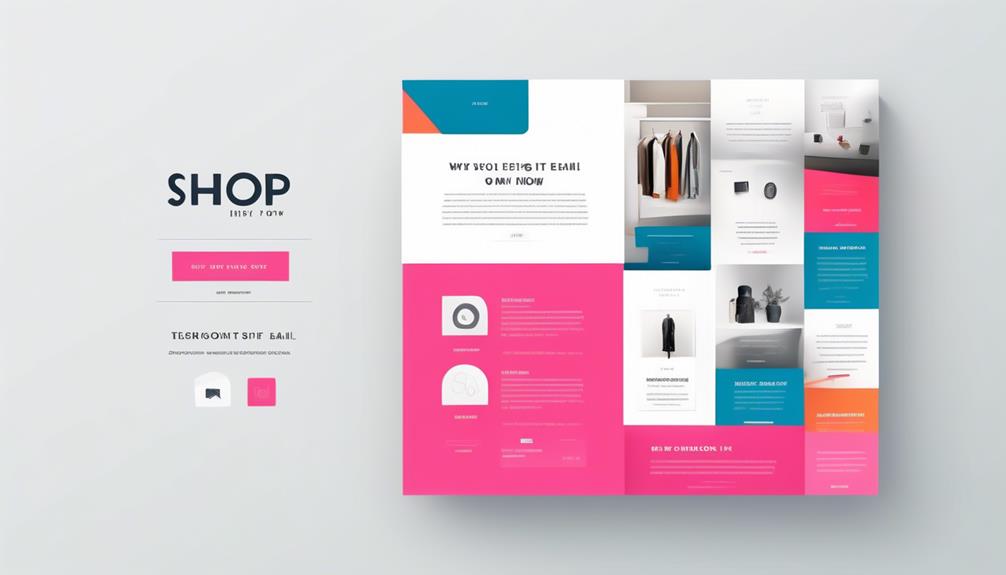
When crafting email designs, we prioritize creating a clear and compelling Call To Action (CTA) to encourage our readers to take specific actions.
A well-designed CTA is crucial for converting email recipients into customers or leads.
To optimize the effectiveness of CTAs, email marketers should strategically place them in the email to attract attention and drive engagement.
Visual appeal and contrasting colors can make the CTA stand out, leading to increased click-through rates.
Additionally, utilizing action-oriented language in the CTA can motivate readers to take the desired action.
As email service providers offer increasingly sophisticated tools, A/B testing can help determine the best time to send emails and optimize the placement and design of CTAs.
Footer
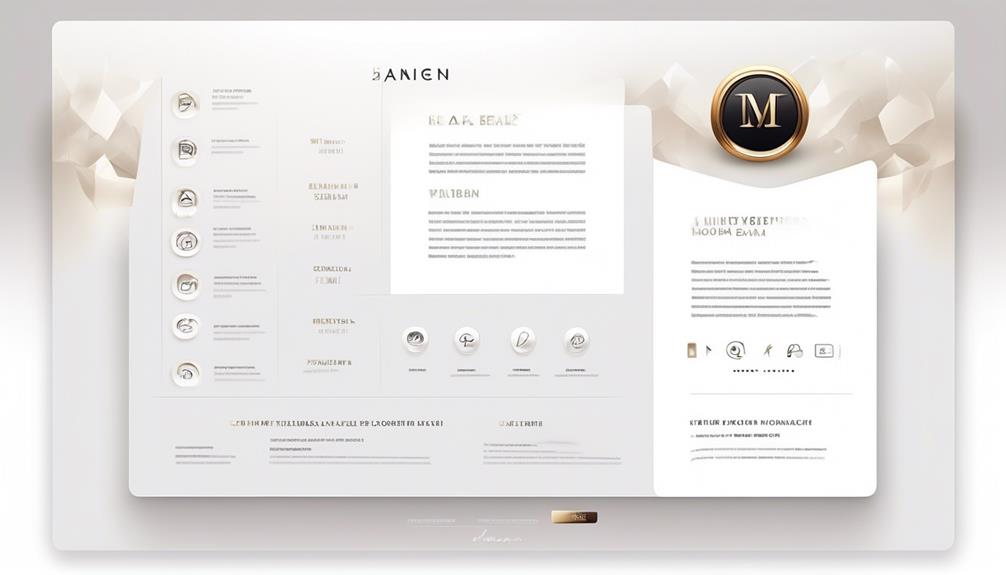
Our email designs prioritize a comprehensive and impactful footer, ensuring that readers have access to essential contact information and options while reinforcing our brand’s identity and values. The footer is often overlooked but plays a crucial role in our email stand.
Here’s what we include in our footer to enhance the email readers’ experience:
- Contact Information: We provide our email address and physical address in the footer to ensure that readers have easy access to reach out to us if needed.
- Unsubscribe Link: It’s essential to include a clear and easy-to-find link to unsubscribe from future emails. This not only complies with regulations but also helps maintain a positive relationship with our audience.
- Brand Reinforcement: Our footer creatively incorporates our unique selling proposition, core brand values, company slogan, store locations, and even special coupon codes. This reinforces our brand’s identity and provides added value to the readers.
Personalization
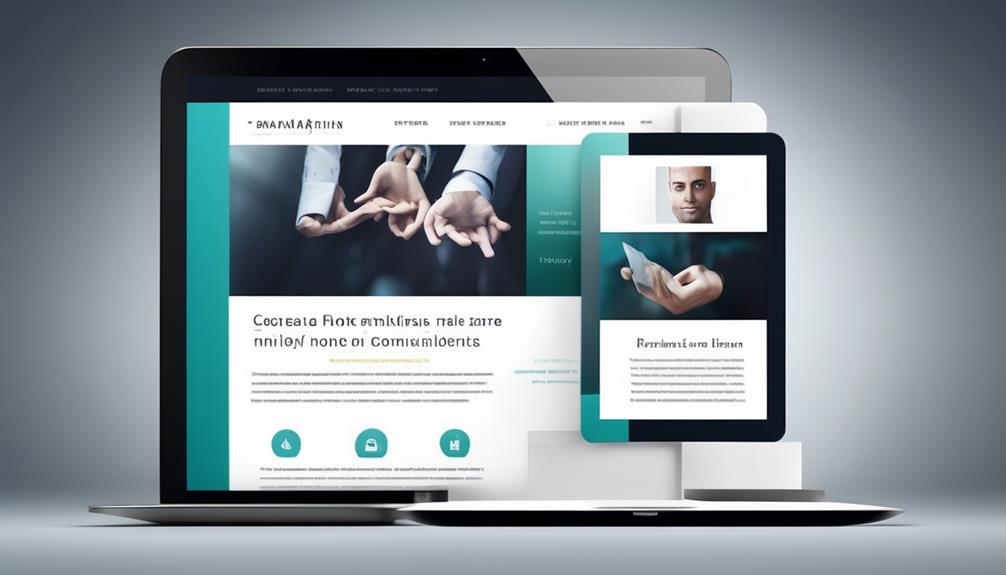
Personalization in email design is crucial for connecting with our audience on a more individual level.
By utilizing dynamic content and user segmentation, we can tailor our emails to provide relevant and personalized experiences for each recipient.
This approach not only increases engagement but also contributes to higher open and click-through rates.
Dynamic Content
Enhancing email engagement and conversion rates, dynamic content (personalization) tailors email content to individual recipients’ preferences and behaviors. Here’s how dynamic content can be optimized:
- Utilize Email Builders: Incorporate dynamic content features offered by email builders to easily personalize emails based on user data and interactions.
- Integrate with Social Media: Leverage dynamic content to pull in social media posts or user-generated content, creating a more engaging and personalized email experience.
- Implement Countdown Timers: Use dynamic content to include countdown timers for limited-time offers, creating a sense of urgency and driving higher conversion rates.
User Segmentation
Utilizing user segmentation allows for personalized email content tailored to individual recipients’ demographics, behavior, and interactions, enhancing engagement and relevance. By dividing your audience into specific segments based on factors such as age, location, purchase history, or email engagement, you can create targeted and relevant content that resonates with each group.
This targeted approach can significantly increase your open and click-through rates, ultimately leading to higher conversion and retention. With years of experience in the email landscape, we’ve seen user segmentation become a popular email marketing strategy, allowing brands to provide a seamless and personalized experience for their subscribers.
Incorporating user segmentation into your email marketing strategy can help you deliver the right message to the right audience at the right time, driving better results and fostering stronger customer relationships.
Layout
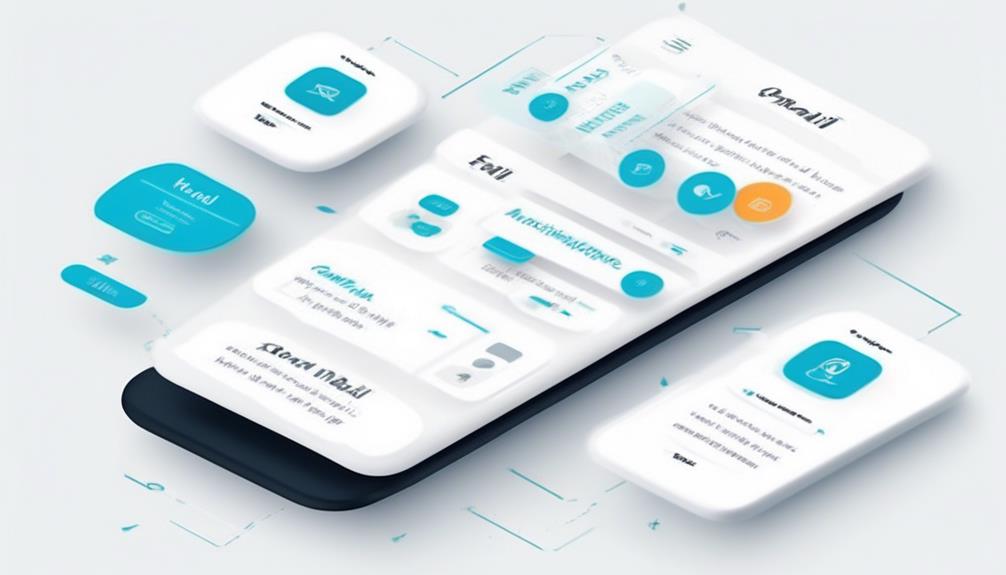
When designing email layouts for 2024, it’s essential to prioritize a responsive template that ensures optimal display across various devices. To achieve an effective layout, we should consider the following:
- Simplicity and Clutter-Free Design: A simple and uncluttered layout enhances readability and ensures a seamless reading flow for recipients. Avoid overcrowding the email with excessive images or text, and strategically use white space to guide the reader’s focus.
- Strategic CTA Placement: The layout should strategically add Call-to-Action (CTA) buttons or links to direct user engagement. Placing CTAs where they’re easily visible and accessible can significantly improve click-through rates and conversions.
- Color Usage: Incorporate a maximum of two colors in the layout, including bright colors strategically to draw attention to essential elements such as CTA buttons or important information. A balanced and thoughtful use of color can enhance the visual appeal of the email without overwhelming the recipient.
Mobile-Responsive

Incorporating mobile-responsive design into email layouts ensures that recipients can seamlessly engage with the content on various devices, maintaining readability and user experience. Mobile-responsive design is essential for optimizing emails for mobile viewing and interaction. It involves using a single-column layout, larger fonts, and touch-friendly elements to enhance readability and usability on small screens. Additionally, optimizing images and testing emails across different mobile devices ensures compatibility. Utilizing a responsive email template is crucial for providing an optimal display on smartphones and tablets. Designing emails with mobile responsiveness in mind can significantly improve user experience and engagement for mobile users.
Mobile-Responsive Design Single-column layout Larger fonts for readability Touch-friendly elements Image optimization for compatibility
A/B Testing
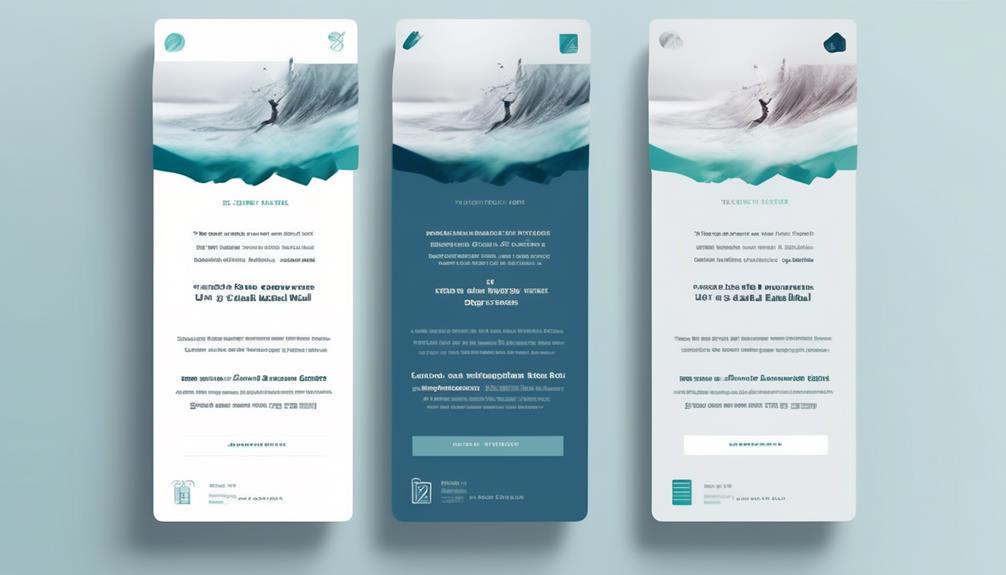
A fundamental practice for optimizing email performance and enhancing subscriber engagement is A/B testing, which involves comparing two versions of an email to determine the more effective design elements.
Here are three key aspects of A/B testing:
- Optimizing Content: A/B testing allows us to compare different types of content, such as text, images, and videos, to see which resonates better with the audience. It helps in understanding what kind of content is more likely to engage subscribers and prompt them to take action.
- Refining Call-to-Action (CTA): Through A/B testing, we can experiment with different CTAs, such as button colors, text, and placement, to determine the most effective way to point readers toward the main message or desired action. This ensures that the CTA stands out and encourages conversions.
- Subject Line and Preview Text: Marketers use A/B testing to refine subject lines and preview text to make sure they effectively capture attention and communicate the value of the email content. This is crucial for increasing open rates and ensuring that the main message gets across to the audience.
A/B testing is a vital tool for optimizing email design and content, ultimately leading to good engagement and conversion rates.
What Are the Key Trends in Email Design Practices for 2024?
In 2024, the best email design practices are expected to focus on interactive elements, personalized content, and mobile optimization. Businesses will prioritize creating visually appealing emails with clear CTAs and minimalistic designs. AI-driven personalization will also play a crucial role in enhancing user engagement and driving email marketing success.
Frequently Asked Questions
What Is the Email Trend in 2024?
In 2024, email trends are all about engaging content, dark mode designs, exclusive visuals, friendly faces, and gamified emails.
These practices create a sense of connection, warmth, and exclusivity, while also improving engagement and understanding.
It’s an exciting time for email design, as we explore new ways to captivate and connect with our audiences.
What Is the Best Email Layout?
Creating a captivating email layout involves balancing aesthetics and functionality. We prioritize a visually appealing design that fosters user engagement. Incorporating clear hierarchies, compelling imagery, and concise copy enhances readability and retention.
Employing responsive design ensures seamless viewing across devices. Strategically placing CTAs and an easy-to-find unsubscribe button maximizes interaction and compliance.
What Are the Trends for Newsletters in 2024?
Trends for newsletters in 2024 are exciting!
Interactive content like GIFs and videos is boosting engagement.
Dynamic personalized content based on user behavior is on the rise.
Dark mode email designs and customized visuals are gaining traction.
Nostalgic design elements and mixed media collages are creating immersive experiences.
These trends are reshaping the email landscape and enhancing user experiences.
Is Email Marketing Still Relevant in 2024?
Yes, email marketing is still relevant in 2024. We engage subscribers, boost open rates, and improve brand recognition.
Personalizing emails, optimizing for mobile, and embracing design trends are crucial. Interactive content, dark mode compatibility, and visual storytelling are key trends.
AI-powered tools, enhanced security, and privacy features are shaping the future. We prioritize mobile-first design and dark mode compatibility to stay ahead in email marketing.
Conclusion
In conclusion, email design practices for 2024 will be all about engaging and captivating the audience.
Like a colorful and dynamic painting, emails will incorporate interactive elements, personalized visuals, and vibrant colors to enhance brand identity and drive engagement.
By focusing on creating visually appealing and interactive content, email designs in 2024 will aim to leave a lasting impression on the audience.
Bryn – AI Expert Writer Bryn is the wizard of words and AI at Influenctor. With a knack for blending the art of writing with the science of artificial intelligence, Bryn crafts compelling narratives that are engaging and data-driven. Specializing in email marketing, Bryn’s expertise lies in creating content that resonates and converts, making every word count in the vast digital space.
Email Design Hub
8 Best Email Design Practices for 2024 Success
Uncover the essential email design practices for 2023 that will elevate your campaigns and capture your audience's attention like never before.
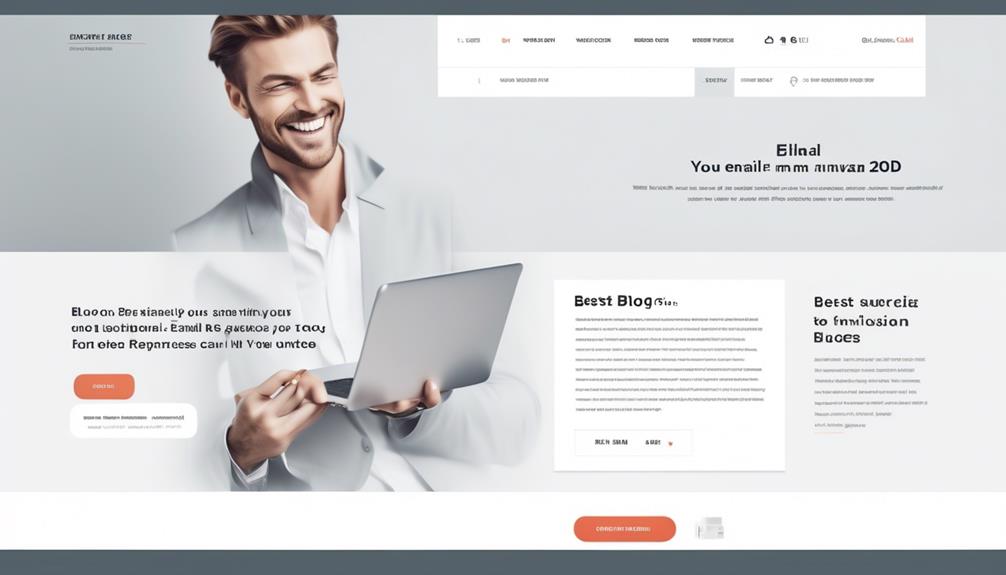
As the landscape of email marketing progresses, the importance of utilizing effective design strategies grows more critical. In a digital environment rife with competitors and distractions, it is vital to distinguish oneself and grab the attention of the target audience.
By implementing the 8 best email design practices for 2024, we can significantly enhance the impact and results of our email campaigns. These practices are not only about aesthetics but also about driving engagement and conversion.
Let’s explore how these strategies can elevate our email marketing efforts and ensure success in the upcoming year.
Key Takeaways
- Personalization is key: Use personalized sender names, subject lines, and preheader text to make your emails more relevant and engaging to recipients.
- Keep it concise: Use concise subject lines, preheader text, and email copy to maintain reader engagement and interest.
- Visual appeal matters: Incorporate high-quality images, a defined color palette, and contrasting colors to enhance the visual appeal of your emails.
- Optimize for dark mode: Accommodate dark mode users by adapting your color choices and creating visually appealing email layouts that work well in both light and dark modes.
Sender Name
In 2024, crafting a personalized and relevant sender name is crucial for maximizing email open rates and engaging recipients effectively. The sender name plays a pivotal role in influencing 68% of Americans’ decision to open an email.
When choosing a sender name, it’s vital to consider the preferences of the target audience and ensure that it aligns with the brand identity. By selecting a sender name that reflects the brand voice and resonates with the audience, marketers can enhance brand recognition and increase the likelihood of user engagement.
To create a compelling sender name, it’s essential to strike a balance between being personal, relevant, and concise. By avoiding generic sender names and instead opting for a combination of a staff member’s name and the company’s name, marketers can improve brand recall and establish a stronger connection with recipients.
Furthermore, a well-crafted sender name can significantly impact the success of email marketing campaigns by making marketing emails more visually appealing and increasing the effectiveness of email content. Therefore, investing time and effort into choosing the right sender name is crucial for achieving optimal results in email marketing.
Subject Line
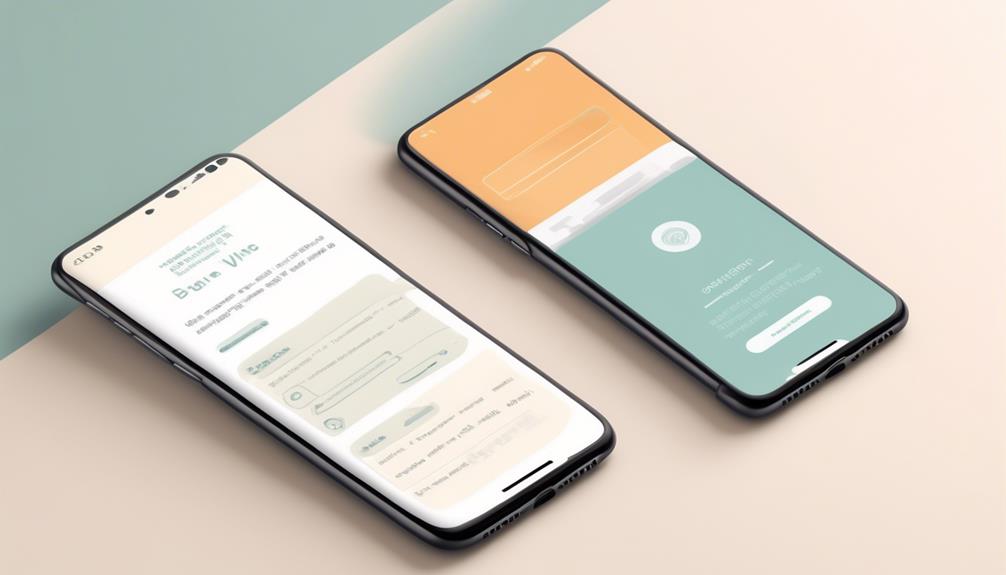
Crafting compelling and engaging subject lines is essential for capturing the reader’s attention and driving higher open rates in email marketing campaigns. In the ever-evolving email landscape, the subject line remains a critical element in optimizing email open rates.
To create an impactful subject line, it’s important to adhere to best practices. Keeping subject lines transparent, honest, and ideally around 41 characters or 7 words in length can maximize open rates. Additionally, incorporating emojis can make subject lines more eye-catching and increase open rates, provided they pique curiosity. Personalizing subject lines to align with the email content is another effective strategy for grabbing the reader’s attention.
A/B testing different subject lines allows for a better understanding of what resonates best with the target audience, ultimately driving higher open rates. It’s crucial to avoid misleading or clickbait subject lines, as they can erode trust and credibility with subscribers.
Preheader
As we aim to captivate recipients and drive higher open rates through compelling subject lines, the preheader emerges as a critical element, providing a preview of the email content and enticing recipients to engage further.
When focusing on email marketing best practices, the preheader should be strategically crafted to extend the impact of the subject line and encourage email opens. To achieve this, we must ensure that the preheader text complements the subject line while adding value, interest, or context to the email’s content. Additionally, personalizing the preheader text can significantly enhance its effectiveness in engaging recipients.
To optimize user experience and leverage email design trends, we should keep the preheader between 30 and 70 characters, ensuring it’s concise and impactful. Moreover, incorporating design elements such as alt text and visual content in the preheader can further enhance its appeal.
As email service providers continue to prioritize responsive emails, it’s crucial to consider how the preheader renders across various email platforms, ensuring its effectiveness on different devices.
Header

Delivering an impactful and visually engaging first impression, the header sets the tone for the email content and entices recipients to delve deeper into the message. When designing the header, it’s essential to incorporate both text and relevant images that align with the brand’s style and the email’s content. The headline should be catchy, providing a glimpse of what the email entails to capture the readers’ attention. Including important links as buttons in the header can also drive engagement and direct readers to specific actions. Moreover, the header serves as a summary of the main gist of the email, giving recipients a preview of what to expect.
To illustrate the components of an effective header visually, consider the following table:
Component Description Text and Images Incorporate both for visual appeal Catchy Headline Tease the email’s content Actionable Buttons Include important links for engagement Summary Give a glimpse of the email’s main message
Email Copy
Moving from the impactful header to the crucial aspect of email copy, we aim to craft concise and personalized content that resonates with our audience’s preferences and maintains their interest. When it comes to email copy, it’s essential to use language that speaks directly to our audience segment, ensuring that the content is relevant and engaging.
Here are some key points to consider:
- Conciseness and Personalization
- Keep the email copy under 200 words to maintain reader engagement and interest.
- Personalize the email copy to add a sense of relevance and connection with the recipients.
- Design and Readability
- Utilize simple, on-brand, and easy-to-read fonts while limiting the number of fonts used.
- Use sans serif fonts in the body text for improved readability and visual appeal.
Images

We prioritize high-quality, strategically chosen images to enhance the visual appeal and storytelling of our emails. Images play a crucial role in engaging our audience, with 65% of email readers preferring visual content. It’s essential to opt for high-resolution images in PNG format, keeping them under 1MB to maintain fast loading times. Each image should serve a specific purpose, aligning with the email’s message and enhancing its visual storytelling.
When using stock images, we ensure they aren’t overused by competitors to maintain originality and brand identity. Moreover, we consider the readability of text over images and always include alt text for accessibility and improved user experience. By incorporating images thoughtfully, we can capture our audience’s attention and convey our message more effectively.
As we design our emails, we keep these best practices in mind to create visually appealing and engaging content that resonates with our subscribers.
Colors
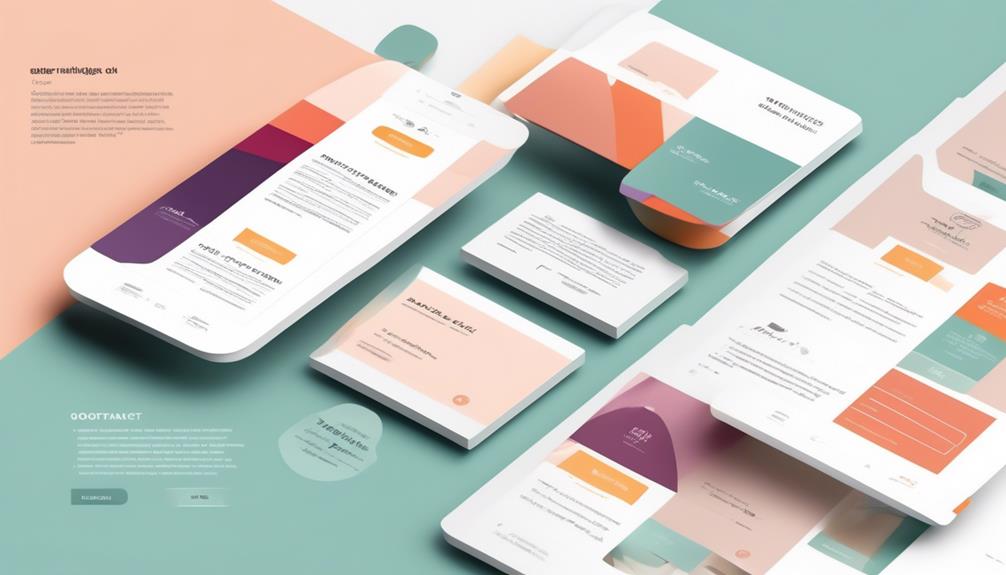
Optimizing the color palette is crucial for creating visually cohesive and impactful email designs that resonate with our audience. When considering the best email design practices, colors play a significant role in enhancing the user-friendly drag and drop experience and overall visual appeal. To achieve beautiful-looking emails, it’s essential to carefully select and implement colors in a strategic manner. Here are some key points to consider:
- Color Palette
- Choose a defined color palette that aligns with our brand and use it consistently throughout our emails.
- Utilize contrasting colors to highlight important sections and create visual interest.
- Visual Appeal
- Avoid using too many colors in the email design to maintain a clean and cohesive look.
- Ensure that the background and text colors complement each other for readability and visual appeal.
In addition to considering traditional email designs, it’s also important to keep in mind the rising popularity of dark mode. Adapting our color choices to accommodate dark mode users can enhance the overall user experience and align with modern email marketing strategy. By incorporating these color practices, we can effectively capture attention, guide focus, and create visually appealing email layouts that compel recipients to open our emails.
Call To Action
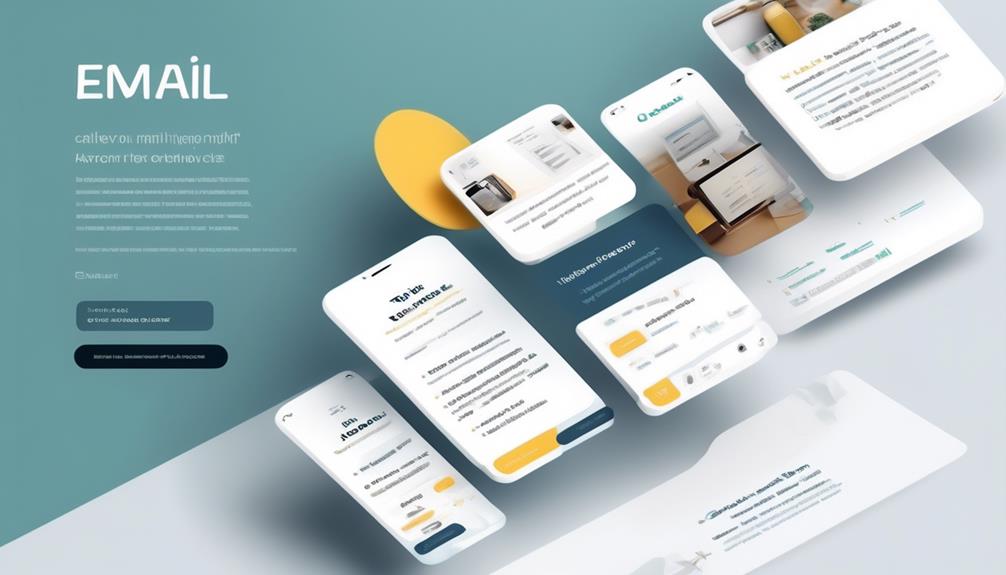
To prompt immediate engagement, ensure that the call to action clearly and visually stands out within the email design. The best email marketer understands the importance of a compelling call to action (CTA) in driving recipient engagement.
Using action-oriented language and strategically placing the CTA within the email can significantly impact click-through rates. With the drag and drop editor, creating visually appealing CTAs has become increasingly popular and accessible. Additionally, utilizing merge tags can personalize CTAs for different segments of your audience, leading to higher conversion rates.
It’s essential to provide actionable information within the CTA, clearly stating the desired action, whether it’s making a purchase, signing up for a webinar, or downloading a resource. Testing different CTAs and their placements can help determine the most effective approach for your audience.
Lastly, including a link to unsubscribe not only fulfills legal requirements but also builds trust with recipients. By following these best practices, email marketers can create more effective emails that resonate with recipients across platforms like Gmail and Outlook.
How Can Implementing A/B Testing Improve Email Design Practices for 2024 Success?
Implementing and mastering email A/B testing techniques can significantly improve email design practices for 2024 success. By conducting A/B tests on different email elements such as subject lines, calls to action, and images, businesses can gain valuable insights into what resonates best with their audience and optimize their email campaigns accordingly.
Frequently Asked Questions
What Is the Email Trend in 2024?
We’ve noticed a surge in interactive content, animated gifs, and customized visuals in email design. Dark mode email designs are also on the rise.
Personalization is key, with dynamic content tailored to individual reader preferences. These trends are shaping the email landscape in 2024, enhancing engagement and brand differentiation.
The evolving email design practices are geared towards creating immersive and personalized experiences for recipients, driving higher engagement and conversions.
Is Email Marketing Still Effective in 2024?
Yes, email marketing is still effective in 2024. We’ve seen high ROI and strong audience engagement.
Personalized and targeted campaigns are crucial. Incorporating interactive elements and dynamic content enhances engagement and conversions.
AI-driven strategies and automation streamline marketing efforts and improve user experiences. Mobile optimization and responsive design are essential for reaching and engaging audiences.
With these practices, email marketing continues to be a powerful tool for success in 2024.
What Is the Best Email Layout?
We discovered that the best email layout combines an eye-catching header, concise preheader, and a compelling subject line.
It’s like crafting a perfect recipe – the right balance of visual appeal, succinct messaging, and a dash of intrigue.
This layout captivates recipients while guiding them seamlessly through the email content.
What Is the Text to Image Ratio for Emails 2024?
We aim for a balanced text to image ratio of 60% text to 40% images in our emails for 2024. This balance ensures optimal engagement and deliverability.
By using images strategically to support our message and enhance visual appeal, we can create effective email designs.
We also prioritize accessibility by implementing alt text for images, ensuring our message is conveyed even if images are blocked.
Conclusion
In conclusion, implementing these email design practices in 2024 will help boost engagement and elevate email marketing success!
By using a personal sender name, compelling subject lines, clear headers, and concise copy, we can captivate our audience and create captivating campaigns.
Additionally, incorporating high-resolution images, a defined color palette, and a strong call-to-action will further enhance the overall impact of our emails.
Let’s embrace these best practices to elevate our email game and achieve outstanding outcomes!
Bryn – AI Expert Writer Bryn is the wizard of words and AI at Influenctor. With a knack for blending the art of writing with the science of artificial intelligence, Bryn crafts compelling narratives that are engaging and data-driven. Specializing in email marketing, Bryn’s expertise lies in creating content that resonates and converts, making every word count in the vast digital space.
Email Design Hub
Crafting Engaging Newsletters: Tips From Top Creators
Want to master the art of crafting engaging newsletters?

Creating compelling newsletters can be likened to sowing seeds in a meticulously cared-for garden; it demands diligent care and nurturing to bear fruitful outcomes. From grasping the needs of your audience to refining your call-to-action, there are numerous critical components that contribute to making a newsletter genuinely exceptional.
But what sets top creators apart in this competitive space? Stay tuned as we explore practical tips and insights from industry leaders that can elevate your newsletter game and keep your subscribers eagerly anticipating your next email.
Key Takeaways
- Tailor content to audience interests and needs
- Personalize content and establish familiarity
- Incorporate clear and compelling CTAs
- Showcase customer testimonials and reviews
Understanding Your Newsletter Audience
Crafting engaging newsletters begins with understanding our audience's interests and needs to tailor content effectively and entice them to open and engage with our newsletters. To create an engaging email newsletter, it's crucial to grasp what resonates with our audience. The newsletter should provide practical tips and information that address their specific interests and challenges. By understanding your newsletter audience, you can personalize the content and ensure it delivers value to the readers.
In addition to understanding their interests, it's essential to incorporate a clear call to action in the newsletter. Whether it's directing them to visit our website, sign up for an event, or participate in a survey, a compelling call to action encourages engagement and interaction. Understanding your newsletter audience also involves recognizing the tone and style that resonates with them. Consistency in the tone and format with the brand and previous newsletters establishes familiarity and reinforces the relationship with the audience.
Ultimately, understanding your newsletter audience enables you to tailor content that captivates their attention and prompts them to take action. Monitoring open rates, click-through rates, and engagement metrics provides valuable insights, allowing for continuous refinement to improve the newsletter's performance.
Crafting Compelling Subject Lines

Understanding our audience's interests leads us to the crucial aspect of crafting compelling subject lines that grab attention and encourage engagement. When creating email newsletters, subject lines play a pivotal role in determining whether recipients open the email or simply ignore it.
To craft engaging subject lines, it's essential to keep them clear and concise, offering a hint of the content inside to pique curiosity. Additionally, personalizing subject lines by addressing readers warmly and using their names, if available, can significantly increase open rates.
A/B testing is a valuable tool for identifying subject lines that generate higher open rates. By experimenting with different approaches, such as using familiar and interesting language while ensuring an appropriate length, creators can influence open rates and ultimately encourage more engagement with their newsletters.
It's crucial to continuously optimize subject lines based on the results of A/B testing and personalize them to increase relevance and engagement. By following these strategies, email marketers can craft subject lines that not only grab attention but also drive meaningful interaction with their content.
Designing Engaging Email Templates
When designing engaging email templates, it's crucial to ensure they're optimized for mobile accessibility and incorporate visually appealing multimedia elements to captivate the audience.
Creating visually appealing email templates involves using images, infographics, and videos to enhance the overall look and feel of the content.
Additionally, incorporating clear and compelling Call-to-Action (CTA) buttons is essential to encourage reader engagement and interaction.
A/B testing different email template designs can help determine which resonates best with your audience, allowing you to refine and improve the template for better engagement.
It's also important to personalize the email template content to cater to the specific interests and needs of different subscriber segments, increasing the relevance and impact of the newsletters.
Incorporating User-Generated Content
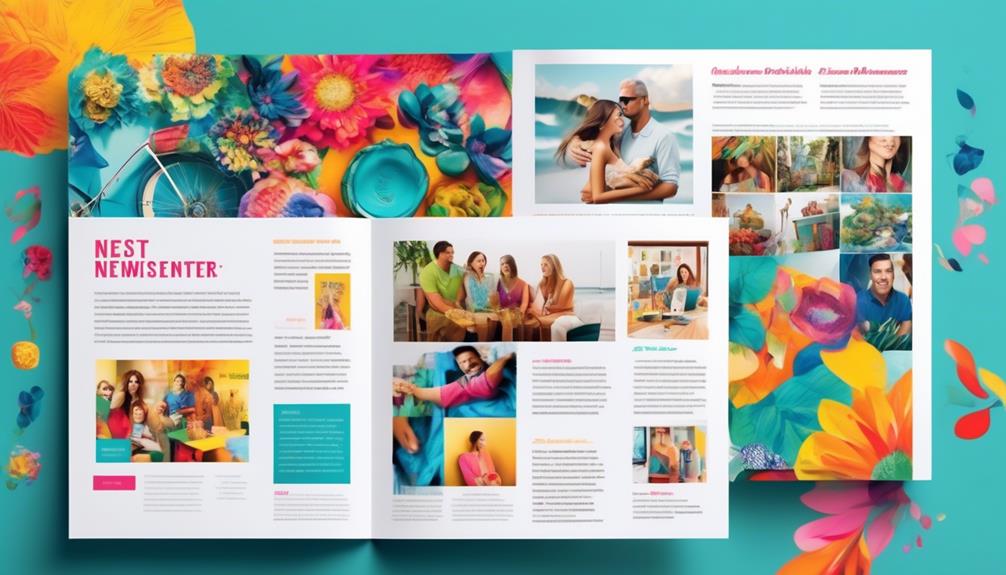
Let's talk about the power of user-generated content in your newsletters.
By showcasing customer testimonials, product reviews, and user stories, you can add authenticity and credibility to your content.
Encouraging user participation and featuring their experiences fosters a sense of belonging and community among subscribers.
User-Generated Content Benefits
Incorporating user-generated content into newsletters creates a dynamic platform for engaging the community and providing diverse perspectives. User-generated content benefits newsletters in multiple ways. It showcases authentic customer experiences, fostering a sense of trust and loyalty. By featuring content created by the audience, newsletters can create a community feel and encourage interaction. This can lead to increased engagement and a deeper connection with the brand. Additionally, user-generated content adds variety and freshness to the newsletter, keeping it interesting and relevant for readers. To illustrate the benefits of user-generated content, we can examine the following table:
| User-Generated Content Benefits | Description |
|---|---|
| Showcases authentic experiences | Demonstrates real-life interactions with the brand |
| Fosters community and interaction | Encourages engagement and creates a sense of belonging |
| Builds trust and loyalty | Establishes credibility and strengthens brand affinity |
| Adds variety and freshness | Keeps the newsletter engaging and relevant for readers |
Authenticity in Newsletters
To maintain the sense of community and engagement fostered by user-generated content, newsletters should prioritize authenticity in their content, particularly through the incorporation of user-generated content. Encouraging user participation and showcasing testimonials, reviews, or user stories can create a diverse and inclusive newsletter.
Leveraging user-generated content adds a personal touch and builds trust with the audience, while curating content that aligns with the brand's values and resonates with the target audience is essential.
By incorporating user-generated content, newsletters can foster a connection between the brand and its audience, creating engaging and educational content that provides industry insights.
This approach not only adds value to the email list but also strengthens the authenticity and relatability of the newsletter, ultimately leading to higher engagement and readership.
Engagement Through User Content
Encouraging readers to actively contribute their testimonials, stories, or experiences can significantly enhance the engagement and sense of community within the newsletter. By incorporating user-generated content, top creators can create a more engaging and personalized experience for their subscribers. Here are some tips for crafting engaging newsletters through user content:
| Tips for User Content Engagement |
|---|
| Encourage submissions of testimonials, stories, or experiences |
| Showcase user-generated content to create a sense of belonging |
| Utilize interactive elements for user participation |
Incorporating user content not only diversifies the newsletter but also makes it more relatable and inclusive. Subscribers will feel a stronger connection to the newsletter and to each other, fostering a vibrant and engaged community. This approach can elevate the overall quality and impact of the newsletter, leading to higher reader satisfaction and retention.
Leveraging Trending Topics and Events

Let's tap into the power of trending topics and events to make our newsletters more engaging and relevant.
By connecting with what's currently capturing people's attention, we can provide timely and valuable content that keeps our audience interested.
From using social media to tease upcoming newsletters to personalizing subject lines, there are numerous ways to leverage trending topics and events for maximum impact.
Trending Topics Engagement
Leverage trending topics and events to create engaging and relevant content for your newsletter. By staying current and connecting your content to popular conversations and events, you can capture reader interest and drive engagement. Incorporating trending topics strategically makes your newsletter more timely and compelling, ensuring it remains current and engaging in the digital landscape. To help you effectively leverage trending topics, we've compiled a list of top trending topics and events to consider for your newsletter:
| Trending Topics | Events |
|---|---|
| COVID-19 updates | Industry conferences |
| Sustainability | Cultural celebrations |
| Remote work tips | Sporting events |
| Mental health awareness | Product launches |
| Diversity and inclusion | Pop culture phenomena |
These trending topics and events provide valuable opportunities to craft engaging content that resonates with your audience.
Event-Based Content
Staying current with trending topics and events allows us to seamlessly integrate timely and engaging content into our newsletters, ensuring our readers remain captivated and informed. Event-based content is a powerful tool in crafting engaging newsletters.
By leveraging trending events, we can create a sense of urgency and relevance, making our newsletters more captivating. Top creators understand the impact of aligning newsletter content with current events to capture the attention of their audience. This approach not only makes the content more relatable but also demonstrates the relevance of our brand.
Incorporating event-based content into our marketing strategy can significantly enhance the impact of our email campaigns. It's essential to tailor our content to connect with trending topics and events, as it can make our newsletters more compelling and actionable for our readers.
Timely Newsletter Inclusions
By aligning our newsletter content with trending topics and events, we ensure timely and relevant inclusions that captivate our readers' interest and attention. Leveraging the latest trends and events in our newsletter can significantly boost engagement and click-through rates.
Here are five ways to incorporate trending topics and events into our newsletter content:
- Create themed content around popular events or seasonal themes to add relevance.
- Share relevant news and updates from the ecommerce business world to provide valuable insights.
- Integrate trending social media discussions or challenges to encourage interaction and participation.
- Highlight trending topics in our industry and provide expert commentary or analysis.
- Offer exclusive promotions or discounts tied to current events to drive sales and customer engagement.
Utilizing Social Media for Promotion
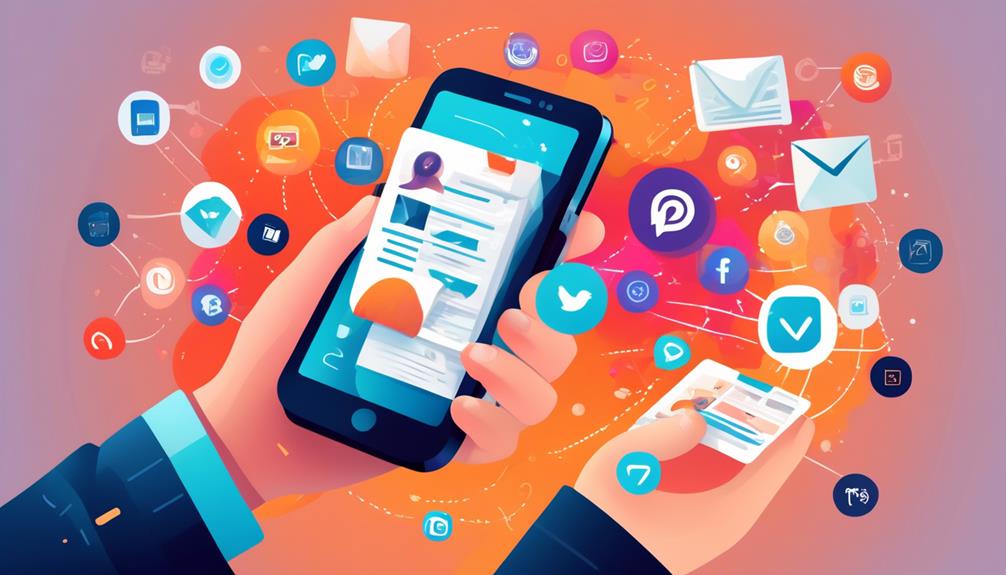
We can increase reader engagement by sharing enticing snippets and captivating visuals on social media to generate curiosity and drive traffic to our newsletter. Utilizing social media for promotion allows us to tease the content of our newsletter, creating interest and encouraging readers to explore the full content. By using engaging visuals and compelling captions, we can attract attention on various social media platforms. It's essential to share exclusive and unique content on social media, providing a clear call to action to engage readers and direct them to our newsletter. Here's a table highlighting key strategies for utilizing social media in newsletter promotion:
| Strategy | Description | Example |
|---|---|---|
| Share snippets | Post intriguing snippets from the newsletter to entice readers to explore the full content. | Tease an interesting fact or statistic. |
| Use captivating visuals | Utilize eye-catching images or graphics to grab the audience's attention and convey the newsletter's essence. | Create visually appealing quote graphics. |
| Provide clear call to action | Include direct instructions or prompts for readers to subscribe or access the full newsletter. | Use phrases like "Read more" or "Subscribe now" to guide readers. |
Implementing A/B Testing for Optimization
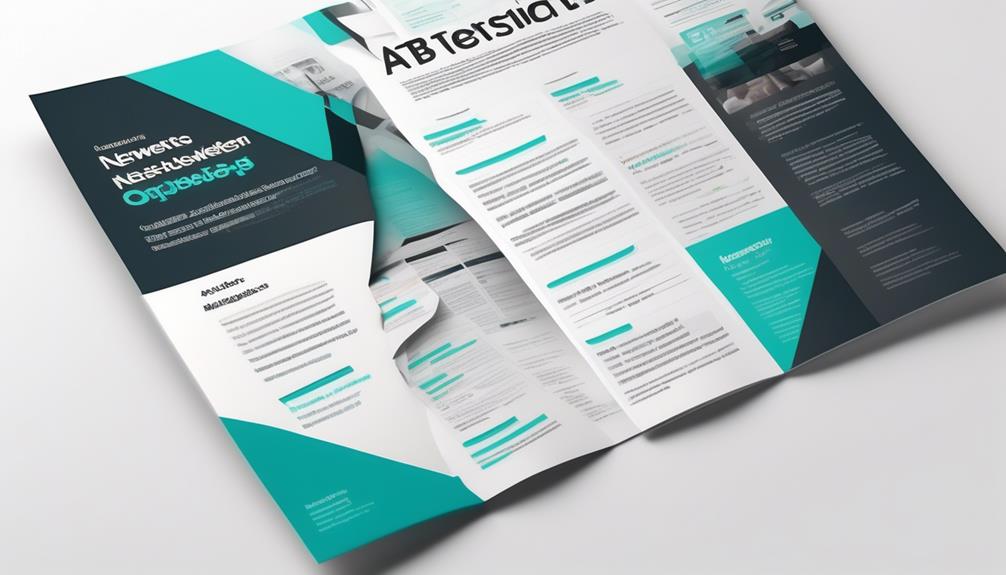
After generating interest in our newsletter through captivating visuals and enticing snippets on social media, we can further optimize reader engagement by implementing A/B testing to refine our subject lines for maximum impact.
A/B testing allows us to experiment with different subject line formats and variations, ultimately determining which ones generate higher open rates. By analyzing the data collected from these tests, we can identify trends and patterns in subject line performance, enabling us to continuously optimize and personalize subject lines to increase relevance and engagement.
This iterative process ensures that our newsletters are crafted with subject lines that resonate with our audience, leading to higher open rates and ultimately, more engaged readers.
- Experiment with different subject line formats and variations
- Determine which subject lines generate higher open rates
- Analyze data to identify trends and patterns
- Continuously optimize and personalize subject lines
- Craft newsletters with subject lines that resonate with the audience
What are the Tips for Engaging Newsletter Content Creation from Top Creators?
Top creators understand the keys to engaging newsletter content. They prioritize delivering valuable and relevant information to their audience. Consistency in publishing, personalized content, and eye-catching visuals are crucial. They also incorporate storytelling and encourage interaction through surveys, polls, and calls to action.
Frequently Asked Questions
How Do I Make My Newsletter More Engaging?
We make our newsletter more engaging by crafting attention-grabbing subject lines.
We also use visual content like images and infographics to capture the reader's attention.
In addition, we include a clear call-to-action to encourage reader interaction.
To ensure the quality of our newsletter, we thoroughly proofread for errors.
Furthermore, we monitor open rates and engagement metrics to refine future newsletters.
This approach guarantees that our content is visually appealing, error-free, and drives reader interaction.
What Are the 3 Pillars That Go Into Designing a Great Newsletter?
Crafting a great newsletter involves three key pillars:
- Audience understanding: We tailor content to audience interests, ensuring attention-grabbing subject lines and engaging visuals. Our newsletters include segmented content and consistent branding.
- Valuable content: We provide valuable and informative content that resonates with our audience. This includes articles, tips, industry updates, and relevant resources.
- Clear call-to-action: Our newsletters include clear calls to action, guiding readers to take specific actions such as visiting our website, signing up for an event, or making a purchase.
We also prioritize proofreading, editing, and footer information to ensure our newsletters are professional and error-free.
How Do I Make a Powerful Newsletter?
We make a powerful newsletter by crafting attention-grabbing subject lines, incorporating visually appealing images and videos, including clear call-to-action, and thoroughly proofreading for errors.
We also monitor open rates, click-through rates, and engagement metrics to refine future newsletters. This ensures our newsletters are engaging and effective.
How Do You Make a Newsletter Fun?
Making a newsletter fun involves crafting catchy subject lines, using captivating visuals, and including a clear call-to-action.
We also monitor open rates and engagement metrics to gauge the impact.
Offering exclusive content to subscribers adds value.
It's essential to keep the content fresh, relevant, and interactive.
Conclusion
In conclusion, crafting engaging newsletters requires a deep understanding of your audience, a knack for compelling subject lines, and an eye for design.
By incorporating user-generated content, leveraging trending topics, and utilizing social media for promotion, you can take your newsletters to the next level.
And don't forget to implement A/B testing for optimization! With a little creativity and strategic planning, you can create newsletters that truly resonate with your audience and drive meaningful engagement.
Bryn – AI Expert Writer Bryn is the wizard of words and AI at Influenctor. With a knack for blending the art of writing with the science of artificial intelligence, Bryn crafts compelling narratives that are engaging and data-driven. Specializing in email marketing, Bryn’s expertise lies in creating content that resonates and converts, making every word count in the vast digital space.
-

 Email Automation2 weeks ago
Email Automation2 weeks agoAutomated Email Marketing 101: A Beginner's Tutorial
-

 Email Warmup4 weeks ago
Email Warmup4 weeks agoWarm Follow-Up Email
-

 Email Design Hub1 month ago
Email Design Hub1 month ago3 Essential Tools for Email Marketing Design Success
-

 Email Marketing2 weeks ago
Email Marketing2 weeks agoWhat Is Email Marketing Advantages and Disadvantages
-

 Email Marketing3 weeks ago
Email Marketing3 weeks agoWhy Email Marketing Is Effective
-

 Email Template2 weeks ago
Email Template2 weeks agoCrafting the Perfect Book Club Invitation Email Template
-

 Email Marketing2 weeks ago
Email Marketing2 weeks agoDoes Email Marketing Work in 2024
-

 Search Engine Optimization2 weeks ago
Search Engine Optimization2 weeks agoSEO Checklist: Enhance Your Site’s Performance
















